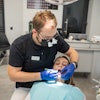
Adolescents who report temporomandibular disorder (TMD) pain and jaw dysfunction are more often exposed to violence, according to a study published recently in the Journal of Oral Rehabilitation.
High stress, including exposure to violence, has been known to increase TMD symptoms. In the study, researchers looked at 2,431 people ages 14 to 19 in Brazil to understand the relationship between self-reported TMD-related symptoms and violence through child physical abuse, intimate partner violence, forced sexual intercourse, and bullying.
"The hypothesis to be tested was that adolescents with symptoms of temporomandibular pain and jaw dysfunction have experienced more violence than adolescents who do not report TMD symptoms," wrote the group, led by Dr. Marcelle Nascimento, PhD, from the department of pediatric dentistry at the University of Pernambuco in Recife, Brazil (J Oral Rehabil, March 28, 2021).
Nascimento and colleagues used data from the 2018 National Survey of School Health (PeNSE), a study administered every two years that asks children to answer questions about their health relations, social context, and leisure time. They focused on high school children in Olinda, a city in northeast Brazil.
The survey asked the children whether they experienced TMD-like pain, including the following:
- Pain in the temples, face, jaw, or jaw joint
- Pain when they open their mouth or chew
- Jaw that catches or locks
The children also answered questions about their exposure to violence. The researchers considered children to have been exposed to violence if they answered yes to questions about intimate partner violence and bullying, or if they said they had been hit, slapped, punched, or kicked.
More than 40% of children self-reported symptoms related to TMD. Children with TMD symptoms were more often exposed to some form of violence, the researchers found.
Children experiencing intimate partner violence or bullying had significantly higher odds of positive responses to TMD-related questions than those who were not exposed to violence. Furthermore, more girls than boys screened positive to all TMD-related questions.
The investigators also found a connection between bullying and temple pain and between forced sexual intercourse and locking or catching of the jaw in girls. Boys who were exposed to bullying also had higher odds of pain and dysfunction.
"Adolescents with self-reported symptoms of temporomandibular pain and jaw dysfunction were significantly more often exposed to some type of violence," the group wrote. "The number of adolescents reporting TMD-related symptoms increased in a dose-response manner with the number of violence forms the individual had experienced."
While nearly 8,000 adolescents were invited to be part of the study, the authors were only able to analyze answers for 2,431 individuals, of which a higher percentage were women and between the ages of 16 and 17. A large number of students also received welfare allowances, which could make the findings not representative of the entire population.
The findings are particularly noteworthy during the month of April, which is National Child Abuse Prevention Month. It's also an important reminder that dentists can help identify children experiencing violence. The authors of the report think histories including exposure to violence should be taken for those with TMD symptoms.
"Although we show a clear association between self-reported symptoms of TMD with exposure to violence, the link with each individual form of violence must be interpreted with caution due to the complex and multifactorial etiology of TMD as well as abuse," they wrote.



















